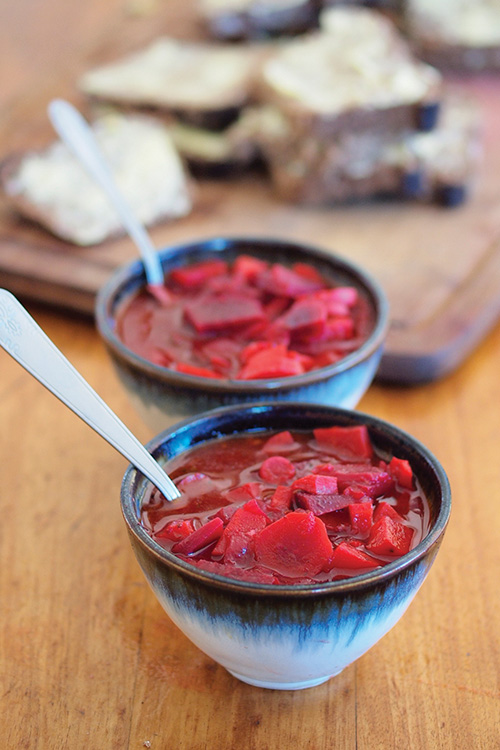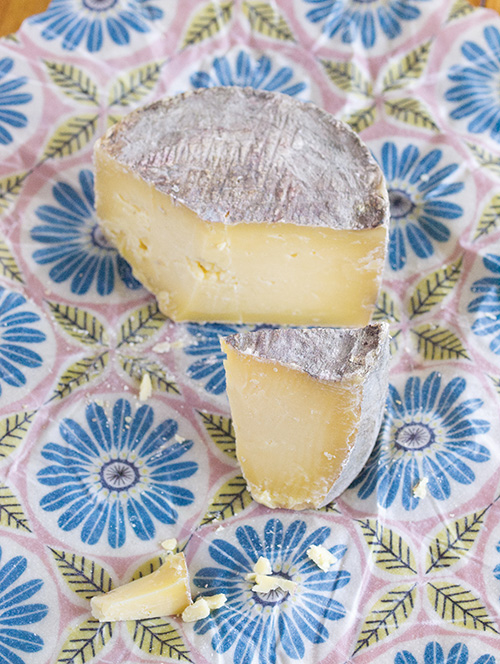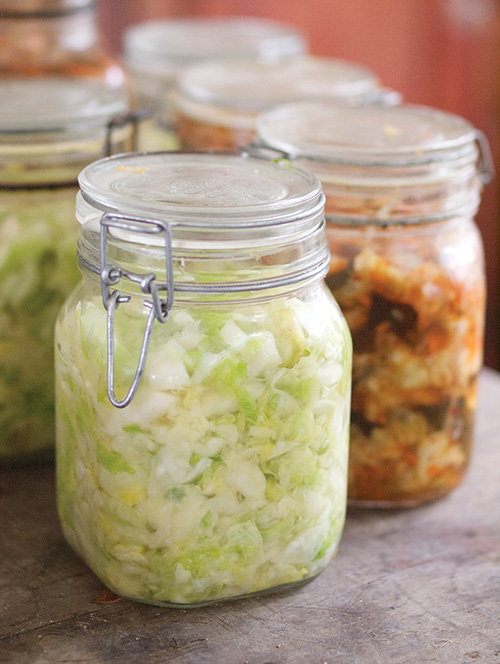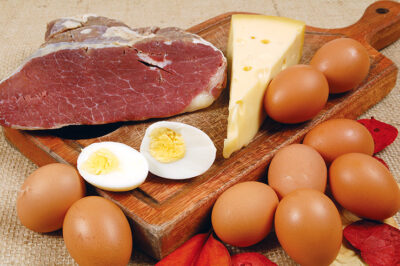From New Dawn 193 (Jul-Aug 2022)
Traditional foods is a term that emerged at some point around the same time the mainstream diet started to resemble something made in Frankenstein’s lab. These are foods produced on small farms and homesteads that have nourished us for millennia.
Traditional food can also be called real food, and a way of eating that focuses on the foods our great great great grandparents would have recognised as foods, such as vegetables, meat, dairy, eggs, fruit, grains, and honey. These foods can be grown on a small scale and don’t need global distribution or factories to feed people.
A traditional foods approach to eating emphasises:
- Meat, fat, eggs, and dairy from animals raised naturally outdoors.
- Animal fats, such as lard, tallow, and butter, for vitamins A, D, and K2, and because they are stable local cooking fats that don’t go rancid when heated.
- Using the whole animal, especially making broth from bones.
- Soaking, sprouting, and fermenting grains to make them more digestible (but grain-free diets can be traditional too).
- Naturally fermented vegetables and drinks.
- Raw and/or fermented dairy.
- Choosing nutrient-dense calories over empty processed-food calories.

Listening to the Wisdom of our Ancestors
The modern way of eating focuses on empty calories that large corporations can easily transport worldwide, such as vegetable oils and white flours. This approach is a modern experiment that has resulted in more chronic illness than any other time in history.
In contrast, when we learn about cultures that weren’t influenced by the modern world (in particular from Weston A Price’s book Nutrition and Physical Degeneration) we find that the same foods feared in the modern world – such as butter, liver, egg yolks, raw milk, and lard – are prized by traditional cultures.
Every culture studied by Weston A Price had a different diet, but each diet was based on nutrient-dense foods that grew locally, rather than generic, easily transported globalist foods. Foods high in vitamins A and D were prized above other foods. Special foods high in these nutrients were often fed to children and parents trying to conceive healthy babies.
Healthy Teeth
The high amounts of vitamins A, D, and K2 in traditional foods diets were found to influence dental health, and it’s no surprise that the people eating diets high in these vitamins had perfect teeth with no cavities, decay, or deformities. Children born to mothers eating these diets grew up to have enough space in their mouths for all their teeth (including wisdom teeth) to form without trouble. This is how we are meant to be – naturally resilient and healthy people, not weak creatures reliant on modern medicine!
When Weston A Price studied people who had left these cultures and moved to a modern lifestyle and diet, he found that the first generation had cavities and tooth decay. The next generation, born to mothers eating modern junk food diets, also had narrow mouths that did not have room for all their teeth to develop without trouble.
Natural Resilience & Natural Childbirth
It is not only dental health in future generations that is affected by diet, but the entire body and the ability to survive without modern medicine.

The entire bone structure was narrowed in children born to mothers eating a nutrient-poor modern junk food diet. They had less room in their noses to breathe through, making flu, colds, and other respiratory issues more difficult to deal with, and the girls were born with narrow hips that later made childbirth more difficult.
In the traditional cultures Weston A Price and others studied, childbirth was not feared and usually went on without trouble. However, when these same people were fed the modern diet for a generation or more, the next generation had the difficult childbirths that we are familiar with, where medical intervention is the rule rather than an exception.
Adopting a traditional foods diet can help turn this around and create future generations that do not need the modern industrial sick care system.
Bone, Joint & Skin Health
As we age, we have more trouble producing the collagen that helps our joints to function well. A traditional foods diet rich in bone broth gives the collagen and gelatine that we need for optimum health. Many people have found that joint and skin problems disappear by including bone broth in the diet.
The modern industrial way of eating has replaced the time-honoured process of making bone broth with “convenient” cubes of stock bought from a supermarket. To mimic the deep natural flavour that we crave from bone broths, modern stock cubes are packed full of MSG and other artificial flavours. This approach of attempting to copy the taste of traditional foods without any care for health is a common theme in industrial foods.
Probiotics & Gut Health
Every year, more and more information comes out about the importance of gut health on our immune systems, mental health, ability to detox, and more. Traditional food cultures often relied on fermentation to preserve vegetables over the winter. These ferments such as sauerkraut and kimchi are packed full of probiotics and are often served as a condiment on the side of every meal.
Naturally fermented drinks were popular in many cultures, such as fermented cider, beetroot kvass, fermented ginger beer, kombucha, and kefir. All of these drinks are beneficial to gut health and taste great.
Milk and cream did not last long without modern refrigeration, and these foods were often fermented to increase their storage life while adding probiotics. Yoghurt, kefir, raw cheese, cultured butter, and cultured cream are all popular sources of probiotics used for their taste and health benefits.
Nutrient Density & Health

Pre-industrial diets contained higher amounts of vitamins and minerals than modern diets. There were no plastic-packed artificial vitamin pills made in factories, just nutrient-dense real food. Traditional bread did not need to be “fortified” with artificial vitamins in the way modern breads are – they were full of the goodness of slowly fermented whole grains, and it’s possible to make bread at home in these same time-honoured ways.
Foods grown in healthy soils produce higher amounts of vitamins than in industrial dust bowl soils. Animals raised naturally outdoors produce higher amounts of vitamin D in their fat. Pre-industrial breeds of farm animals thrive without modern medicines and produce more of these healthy fats than modern breeds. Raw dairy contains more vitamins and minerals than pasteurised dairy and is more easily digested.
To process wholegrain flour into white flour requires a lot of time-intensive sifting, and traditional cultures that eat grain rely on wholegrain flour with its natural vitamins intact. Therefore, grain was often freshly-ground as needed, leading to less oxidising and nutrient loss.
Modern diets rely on calories devoid of nutrients, such as white flours, vegetable oils, and a long list of unpronounceable ingredients. In pre-industrial diets, nearly everything eaten has some benefit to health, as these healthful foods are what is produced in nature and in natural farming systems without being refined by factories.
The high amounts of vitamins A and D in traditional foods diets help the immune system, eye health, hormone function, bone health, and more. Cholesterol is essential for brain function. Something to reflect on in these times of low cholesterol diets and mass hysteria!
Listening to Nature, Listening to Ourselves
Many of the foods we crave are actually very healthy. The chips and gravy we might want on a cold day could mean that our bodies need animal fat and collagen-rich bone broth, not the vegetable oils and MSG in the modern version. With ice cream, we crave dairy fat. The desire for fizzy drinks is our bodies wanting fermented drinks such as kombucha, water kefir and whey soda. The cliché of a pregnant woman craving pickles means she needs some fermented raw sauerkraut and other healthy probiotic foods.
Each of these foods that we might sometimes crave are very nourishing for health, yet the industrial food system has exploited these natural cravings and directed them towards their products made chiefly from nutrient-poor starches, vegetable oils, sugar, and artificial flavours.
An Ecological Way of Eating
A traditional foods diet can help the much-needed transition from factory farms and dust bowl grain farming back to the traditional mixed farming method that cares for soil life and wild animals. Eating in a way that encourages diverse small-scale farms that value animals for producing fertility and food for a diet that can help create a better future.
If we despise globalisation, there is something to be said for eating local foods, grown by ourselves or bought directly from real people rather than evil corporations. We can prove to ourselves and others that we can survive and thrive without any aspects of globalism by choosing locally-grown traditional foods. Positive actions on a small scale, starting in the kitchen, can have lasting effects.
How to Get Started with Traditional Foods
Eat fermented foods every day and drink fermented drinks.
Avoid processed foods, vegetable oils, and refined sugars.
Cook from scratch as much as possible.
Choose old-fashioned animal fats, such as butter, ghee, lard, and tallow.
Choose animal foods from animals being raised naturally, outdoors.
Make bone broth.
Choose real sourdough bread over processed bread.
Kate Downham’s book A Year in an Off-Grid Kitchen: Homestead Kitchen Skills and Real Food Recipes for Resilient Health, is available from all good bookstores.
References
‘Lard is a Health Food’ by Kate Downham, New Dawn #189
‘The Healing Power of Bone Broth and How to Make it’ by Kate Downham, New Dawn #192
A Year in an Off-Grid Kitchen by Kate Downham
The Complete Book of Self Sufficiency by John Seymour
Nutrition and Physical Degeneration by Weston A Price
Nourishing Fats by Sally Fallon Morell
Traditionally Fermented Foods by Shannon Stonger
© New Dawn Magazine and the respective author.
For our reproduction notice, click here.


